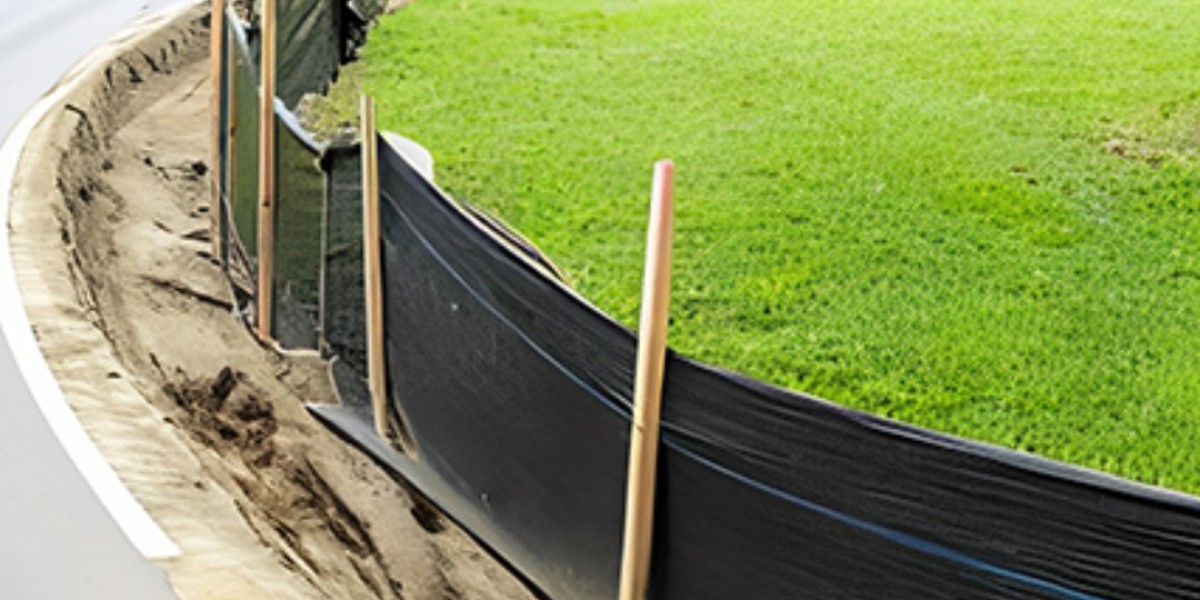Silt fences are a critical component in controlling erosion and managing sediment in construction sites, agricultural fields, and other areas where soil disruption occurs. These barriers, made from permeable geotextile fabric, help to contain and filter sediment-laden runoff while allowing water to pass through. Silt Fence Manufacturers in Delhi are widely used to protect water bodies from contamination, prevent soil loss, and comply with environmental regulations.
In this article, we’ll explore what a silt fence is, how it works, its benefits, applications, installation processes, and answer some common questions about this important tool for erosion control.
What is a Silt Fence?
A silt fence is a temporary barrier constructed using woven or nonwoven geotextile fabric, typically made from polypropylene or polyester, which is staked into the ground to prevent sediment from being carried away by water runoff. The fence acts as a filter, trapping soil particles while allowing water to pass through. These fences are commonly installed around the perimeter of construction sites, agricultural areas, and other disturbed landscapes to prevent soil erosion and protect nearby water sources from sediment pollution.
The fabric used in a silt fence is designed to be permeable, allowing water to flow through while capturing larger sediment particles. The fabric is attached to posts, typically made of wood or metal, which are driven into the ground to create a stable barrier. Silt fences are temporary and are removed once the risk of erosion or sediment runoff has diminished.
How Does a Silt Fence Work?
Silt fences are designed to slow down and control the flow of water across disturbed or loose soil. When rain or irrigation causes water to flow over the surface of disturbed land, it can carry loose soil particles with it. If unchecked, this sediment-laden runoff can enter streams, rivers, and lakes, causing contamination and environmental damage.
The silt fence intercepts the runoff, allowing the water to pass through the fabric while capturing the sediment. As the water slows down, the sediment settles out, and the silt fence traps it, preventing it from moving further. This process not only reduces the amount of soil loss from the site but also helps prevent pollution of nearby water bodies.
Benefits of Using Silt Fences
Erosion Control: Silt fences are highly effective in controlling erosion on construction sites and disturbed land. By capturing sediment before it can be carried away by runoff, these barriers help maintain soil integrity and prevent land degradation.
Environmental Protection: One of the primary reasons for using silt fences is to protect water bodies from sediment pollution. Sediment can carry harmful chemicals, nutrients, and pollutants that can degrade water quality, harm aquatic life, and disrupt ecosystems. A properly installed silt fence helps to prevent this by capturing sediment at its source.
Regulatory Compliance: Many construction projects are subject to environmental regulations that require measures to be in place to prevent sediment from leaving the site. Installing silt fences is a common way to comply with these regulations and avoid fines or project delays.
Cost-Effective Solution: Silt fences are a relatively inexpensive way to manage sediment and erosion on a site. They require minimal materials and labor to install, making them a cost-effective solution for projects of all sizes.
Easy Installation and Removal: Silt fences are simple to install and can be quickly removed once the project is complete or the risk of erosion has passed. This makes them a convenient option for temporary erosion control measures.
Versatile Application: Silt Fence Price can be used in a variety of settings, including construction sites, agricultural fields, residential developments, and roadways. Their adaptability makes them a valuable tool for any project where soil disturbance occurs.
Common Applications of Silt Fences
1. Construction Sites
Construction sites are one of the most common places where silt fences are used. These sites often involve large-scale earthmoving, which can leave soil vulnerable to erosion. Silt fences are installed around the perimeter of the site to prevent sediment from being carried away by stormwater runoff.
2. Agricultural Fields
In agriculture, silt fences are used to control erosion in fields where crops are planted or harvested. They help prevent soil loss due to wind or rain and keep sediment from entering nearby streams or rivers, which can protect water quality and reduce the impact of farming on the environment.
3. Road Construction
Road construction projects can result in significant soil disruption. Silt fences are installed along the sides of the construction area to prevent sediment from entering drainage systems or nearby water bodies, ensuring that the project meets environmental regulations.
4. Residential Developments
New residential developments often involve grading and landscaping that can disturb the soil. Silt fences help manage runoff and erosion during the construction process, protecting both the environment and the property.
5. Wetland and Waterway Protection
Silt fences are frequently used to protect wetlands, rivers, lakes, and other sensitive water bodies from sediment contamination. They act as a buffer between the disturbed land and the water, preventing sediment from entering the ecosystem.
Installation Process for Silt Fences
Proper installation is key to the effectiveness of a silt fence. Follow these steps to ensure the fence performs as intended:
Site Preparation: Before installation, identify the areas where runoff is likely to occur, such as slopes, low-lying areas, or near water bodies. Mark the perimeter where the silt fence will be installed.
Trenching: Dig a trench along the line where the fence will be installed. The trench should be about 6-8 inches deep to allow the fabric to be anchored securely in the soil.
Post Installation: Drive the posts into the ground, spacing them approximately 6-10 feet apart, depending on the site conditions. The posts should be sturdy enough to support the fabric under the pressure of water flow and sediment buildup.
Attaching the Fabric: Attach the geotextile fabric to the posts, ensuring that the fabric extends into the trench. Use staples, ties, or other fasteners to secure the fabric tightly to the posts. The fabric should be taut, with no sagging.
Backfilling the Trench: Once the fabric is in place, backfill the trench with soil, compacting it to ensure that the fabric is securely anchored. This prevents water from flowing underneath the fence.
Maintenance: Regularly inspect the silt fence for any signs of damage or sagging. Remove any accumulated sediment when it reaches about one-third of the height of the fence to maintain its effectiveness.
Conclusion
The Silt Fence For Erosion Control are an essential tool for managing erosion and controlling sediment runoff in a variety of settings, including construction sites, agricultural fields, and road projects. Their cost-effectiveness, ease of installation, and ability to protect the environment make them a widely used solution for preventing soil loss and protecting water quality.
By understanding how silt fences work, their applications, and how to properly install and maintain them, you can ensure that your project complies with environmental regulations and minimizes its impact on the surrounding ecosystem.
Frequently Asked Questions (FAQs)
1. How long can a silt fence remain in place?
Silt fences are designed to be temporary erosion control measures. They can remain in place for several months to a year, depending on the project. However, they should be removed once the risk of erosion has subsided, or the construction project is complete.
2. Can silt fences be reused?
While the posts of a silt fence can be reused, the fabric is typically not suitable for reuse after it has been removed. The fabric can become weakened or damaged over time, making it less effective in future installations.
3. How much maintenance does a silt fence require?
Silt fences require regular inspection and maintenance to ensure they remain effective. This includes checking for sagging or damage, repairing any tears in the fabric, and removing accumulated sediment when necessary.
4. What types of soil conditions are suitable for using a silt fence?
Silt fences can be used in a variety of soil conditions, but they are most effective in areas where the soil is fine, such as silt, clay, or loam. Coarser soils, like sand or gravel, may require additional erosion control measures in combination with a silt fence.



